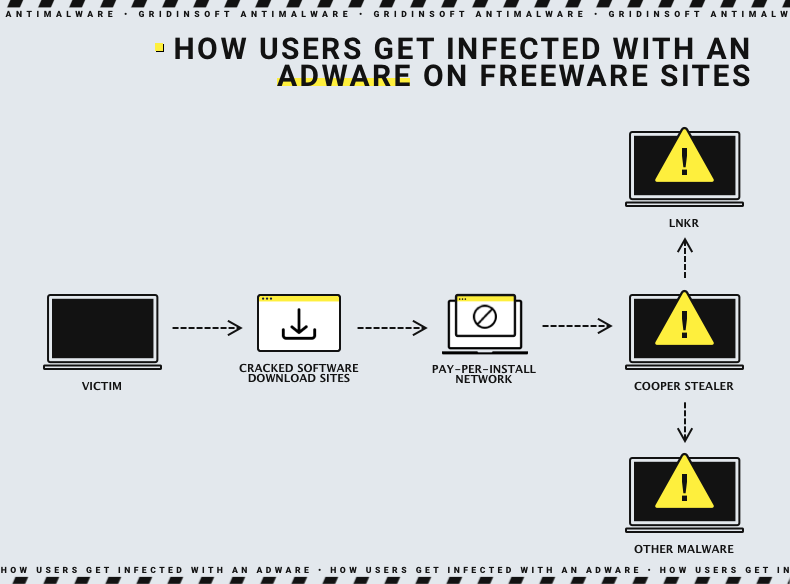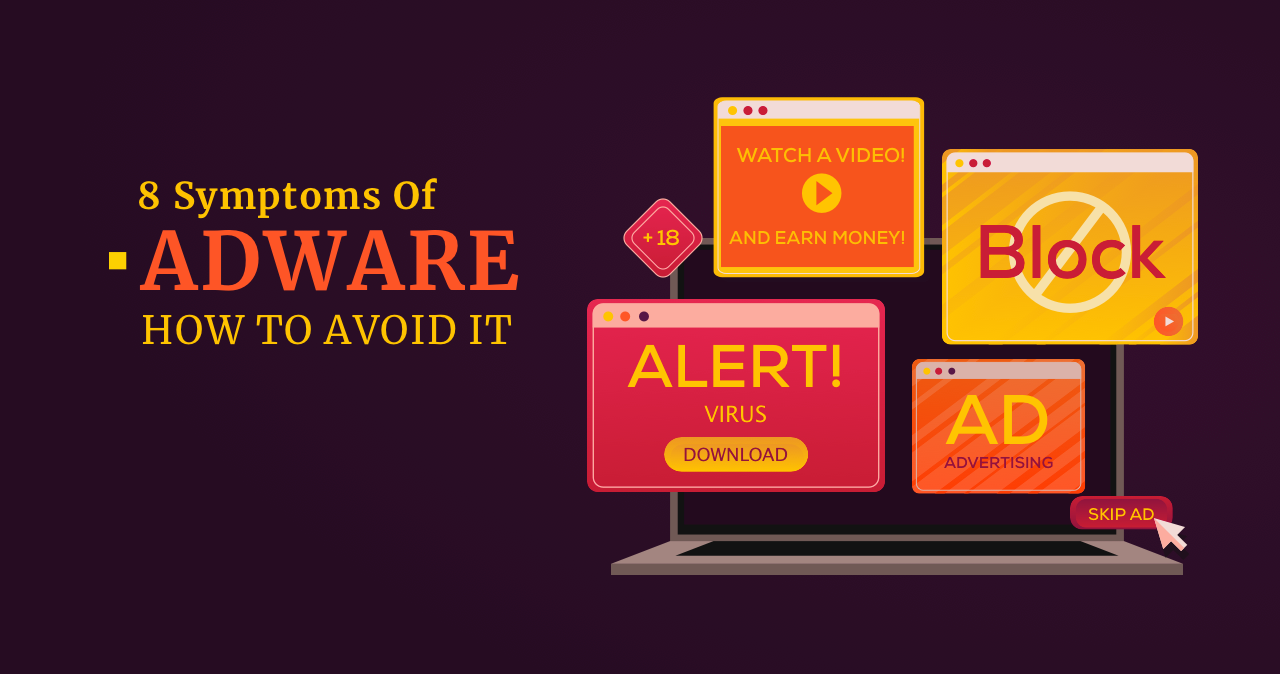What is adware meaning? It is an agressive software whose goal is to collect marketing information about the user loading them with an avalanche of advertisements, often in the form of pop-ups, text links, or banners. Users may download this kind of program unknowingly when it comes in a bundle with other software package users intended to download.
Sometimes developers themselves include adware in their software to partly cover development costs or make the software free for users. If users want free ad software they will need to buy a premium subscription. The main danger that comes from adware is that it often gets exploited by threat actors in various ways and once on the targeted device it takes a significant toll on the device’s operations and state.
Understandable for users this program seems frightening and the premonition is justified. Because it prevents the device from performing proper tasks slowing down the browser and in some cases causing substantial harm to the user’s data. Adware mainly targets personal computers but mobile devices may also be infected with this kind of threat.
But the problem and its risks could be reduced if you learn how to identify and mitigate them. The next top eight signs may hint that you’re dealing with adware infection.
You literally get bombarded with an avalanche of various kinds of advertisements
Pop-up windows are one of the most common signs of the presence of advertising software on your device. It sometimes can be hard to click them away because they continually pop up on your screen. The other annoying thing about them is that they appear in unusual places on your device.
When visiting different websites, you may notice various banners or forms that supposedly need to be filled in or advertisements that urges you to follow some strange links. Because this kind of malware is mainly aimed at stealing the user’s sensitive and valuable information the ads may be designed in various ways so that the victim will click on it.
Be careful with these ads because clicking on them you can not only lose your sensitive and important information but also get yourself another portion of malware like spyware, trojans, even ransomware.
You started to experience lack of storage on your PC
Adware aims to steal not only your privacy but also to cause some harm to documents and files. After adware has infiltrated your PC, the hard drive gets to be filled with all sorts of unnecessary and unfamiliar programs that may have clogged up your storage to its limits.

It means that if you see a new program on your desktop that you don’t remember to install, then don’t rush to click on it because once you do so you can do even more damage to your computer than getting it infected with an adware. Better find the name of this program on the Internet and make sure it is not malicious. If you do find that this program is a rogue one then scan your PC with antivirus protection and get rid of it.
Your hard drive works strange
When adware appears on your device, the hard drive will begin to show suspicious and unusual activity. This means that you will notice an excessive load on your computer at a time when not even a single program will work. You will also be disturbed by notifications that the hard drive is full, although it is not.
Your PC started to perform sluggish and slow
It is worth adding the fact that when adware appears on the device, the work of the device itself will be significantly slowed down. This sign is too obvious to miss and certainly hints that something is wrong with your device. You will notice that your operating system simply stops to properly upload all that it was tasked with or do so with considerable slowness. The good idea here would be to check if you have run out of RAM and start taking appropriate steps to deal with the problem.
To check RAM, you can follow the instructions below:
In Windows PC:
- Press the key combination Ctrl + Shift + Esc and open your task manager. Then you need to go to the Performance tab to see how many GB of RAM is being used within each section.
In the Mac PC:
- Launch the Activity Monitor app. Then go to the System Memory to see the RAM usage.
If after this check the RAM is in order, then you need to look for the presence of virus in the operating system.
Strange Browser Homepage Redirections
If adware appears, the home page redirection may begin to behave unusually strange. You can ask to open one page, but you will be moved to some completely third-party pages. This happens because at some point you clicked on a pop-up window and installed the malware. And it made some adjustments to your device and in particular your browser.
The adjustment is done so every time a victim will open their browser the adware will redirect every search input to the pages completely different from the intended purposes of the search. Be aware that whatever web service you have been maliciously redirected don`t click on anything or in any other way interact with just close the malicious tab and start looking for the source of messed up redirections.
Unexpected Warning Messages And Strange Behavior
If you start to encounter some strange messages that carry warning signs and on general view your device starts to behave strangely enough for you to suspect that something might actually be wrong, then you may have an adware on your PC. It’s a common sign of the malware presence when a user`s device starts to behave not in a way it normally used to behave. We should also warn you that you might also experience an infection of a scareware or spyware that might cause strange and unusual behavior and pop up various fake warning signs.
Here are some examples of signs that you need pay attention to and deal with the potential malware as soon as possible:
- Automatic closing and opening of your programs;
- Windows shuts down for no reason;
- A strange message appears that says you have lost access to some of your drives.
Your Antivirus Programs Stopped Working
If you notice that your antivirus protection does not work, although your license should still be valid, then you might have adware. This may seem strange, but some kinds of adware specifically targets the protection software on victims` devices. But they can wage their attacks only on traditional anti-malware. We recommend not to forget about installing a good protection program, regularly updating it as required by the developers.
All Files Turned Into Shortcuts
If after using some external USB drive you later notice that your files and documents are in the form of shortcuts, then such sudden change may hint that you actually have an adware infection. In addition these labels can be not available, which only further confirms the fact of infection. But beyond that, these infected files can jeopardize the rest of the software on your device.
How to Avoid Adware Malware Infections?
All the above-mentioned information explains how to discern the signs of adware infection. But it’s of course better to avoid the problem than to deal with it, so we will provide you with the simplest rules that you should follow when securing yourself, your data, and your device from future adware attacks:
- Avoid installing freeware and shareware. Such kinds of programs often turn out to be filled with malicious elements and among them not only adware but various types of trojans, spyware, even ransomware. Don’t download or click on these programs even if they seem to be copies of some official software that you actually have to pay money for;
- Download software only from reliable and trusted sources. Peer-to-peer file-sharing platforms and sites are famous enough for being the hosts to malware infected files. It will be better to download an app, files or other software only from reliable and trusted sources only. These could be official app stores ( for example, Google Play and Apple App Store), official developer and manufacturer websites, etc;
- Read before you accept any terms and conditions. Sadly, it is a popular habit of not reading all the conditions of an app or other software before downloading and installing them ( On the other hand how can we blame users who don’t have the patience to read seemingly endless scrolls of terms and conditions even of a simple image editor).
But that’s where the problem is when users accept terms and conditions thus granting an app permissions they don’t have a slightest clue about and actually just ticking away everything they allow the app including installing an adware; - Use antivirus and anti-malware tools. Here we would suggest you one of the adware cleaner try to use our Gridinsoft Adware Removal Tool product to help you remove adware from the device. The antimalware tool is excellent at detecting and protecting against malware. We also should mention that this tool won’t not slow down the work of your PC, effectively stopping and removing various kinds of cyber threats. After downloading and installing it you will forget about all the above signs, the protection program will be perfectly able to relieve you from them and help you get rid of the adware.





How do I get rid of Adware? McAfee will not go away. I don’t want to just change to a paid for system unless it will work
Is there a simple solution to stop interference to use of the Internet?
I have no website.